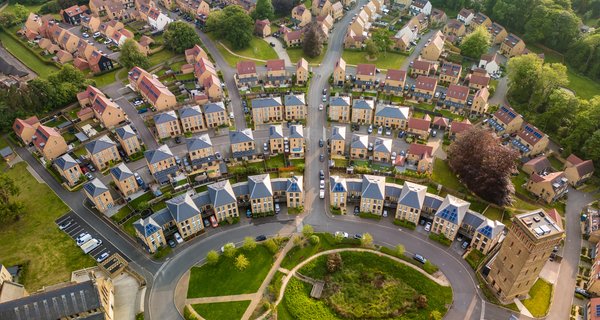Introduction
To meet its climate goals the UK needs to transition its homes to low-carbon heating by 2050. Heat pumps are widely expected to be the most common technology for low-carbon heating, and the UK Government aims to have 600,000 heat pumps installed annually by 2028. However, progress has been slow and the market is not currently growing fast enough to reach this target.
Cost is the most commonly cited barrier to getting a heat pump. For most homes, a first-time installation of an air-source heat pump is significantly more expensive than getting a replacement gas boiler [1]. Even with a £7,500 government subsidy, heat pumps cannot always compete on upfront costs [2]. A typical air-source heat pump costs around £12,000 to install (£4,500 after subsidy) compared to £1,500 to £2,300 for a typical gas boiler. Part of this reflects the cost of doing a first-time heat pump installation and making adjustments to home heating systems to accommodate a heat pump. While costs will be lower for replacement heat pump installations, the majority of heat pump installations over the next decade will be first-time installations and will carry these additional costs.
Alongside the upfront cost, heat pumps are not as cheap to run as they should be. They are extremely energy efficient; an air-source heat pump typically uses three to four times less energy than a gas boiler to produce the same amount of heat. But this efficiency premium is cancelled out by the high cost of electricity relative to gas. A unit of electricity in the UK is currently around 4.1 times more expensive than gas, one of the highest ratios in Europe. As a result, a household that switches to a heat pump is currently unlikely to save money on its energy bills. Ideally, heat pumps should have much lower running costs to offset the larger upfront cost.
If the UK is to stay on track to decarbonise home heating, heat pumps must become more affordable. Fortunately, there is considerable scope for policy action to bring down the overall relative costs of heat pumps.
The goal should be cost parity between heat pumps and gas boilers
We argue that governments in the UK should aim for cost parity between heat pumps and gas boilers in a typical home, and that this is achievable with the right policy changes. In our analysis, we focus on cost parity in terms of whole-life costs, combining upfront cost with running costs over the lifetime of a heat pump. We expect that most households will buy heat pumps using finance in future as the market scales up, which makes lifetime cost especially important. Achieving lifetime cost parity would mean that the monthly cost of heating a home with a heat pump – including paying for the installation – should be the same as with a gas boiler or lower.
There is considerable scope for innovation to reduce upfront costs, although we do not think that it is feasible to bring the first-time installation cost for a heat pump down to the level of a boiler in the near term. However, by combining action to reduce running costs with subsidies and affordable finance, our analysis suggests that the total cost of a heat pump for a typical household can become less than a gas boiler. Achieving this is critical both to making heat pumps affordable to all households and ensuring they can ease, rather than exacerbate, fuel poverty.
Governments in the UK will also need to grapple with the future trajectory of subsidies. Subsidies are currently helping to stimulate heat pump uptake, but may not remain affordable as the heat pump market scales up. If the number of heat pumps installed grows over time into the hundreds of thousands, the cost to governments will grow rapidly unless subsidies are reduced. But reducing the size of the subsidy risks stalling heat pump uptake, unless other measures are in place to reduce costs. Keeping subsidies affordable without reducing the incentives to get a heat pump will be a particularly acute challenge for governments in the late 2020s and 2030s.
Aims of this analysis
This analysis aims to explore how various factors affect the whole-life costs of heat pumps and boilers. We identified conditions that could lead to price parity between heat pumps and gas boilers over the next decade. We present three scenarios which demonstrate the trade-offs between policy choices and interactions with market and technological developments. These are compared to a baseline scenario in which no policy action is taken. The three scenarios are:
- A ‘High innovation’ scenario, in which upfront costs of heat pumps fall quickly and efficiency increases
- A ‘Cheaper electricity’ scenario, in which electricity costs fall more rapidly compared to gas
- A ‘High subsidy’ scenario, in which subsidies for heat pumps remain higher for longer.
Each of these scenarios gets heat pumps to, or close to, cost parity with gas boilers for most households over the next decade. The ‘High innovation’ scenario offers the largest advantage for the longest.
The scenarios involve varying five main factors that will influence the cost of a heat pump relative to a gas boiler:
- The upfront cost of installation.
- We have tested two different trajectories where upfront costs fall by 2.5% and 4.5% each year.
- The level of government subsidy.
- In all our scenarios the existing £7,500 subsidy remains until at least 2028 before gradually reducing at different rates.
- The cost of electricity relative to gas.
- A key factor in the cost of electricity and gas is the levies, which are currently higher on electricity than gas. All of our scenarios involve rebalancing the levies away from electricity and towards gas to different extents.
- The efficiency of the heat pump.
- Seasonal Coefficient of Performance (SCOP) is a measure of how much heat is produced by a heat pump for a unit of electricity used.
- The interest rate for financing a heat pump.
- Our analysis assumes all households will purchase heat pumps on finance, with 5% interest rates. Even where households do not use finance, the interest rate reflects the opportunity cost of not investing the money elsewhere.
The whole-life cost of each device in the scenarios is calculated by adding up the cost of installation and running costs and dividing them by 15 (the assumed lifespan of both heat pumps and boilers) to get the average annual cost. Our analysis includes interest rates, so is intended to approximate the full yearly cost a household would pay if buying a heating system on finance.
The resulting costs are presented separately for different types of homes. The price of a heat pump and a gas boiler varies depending on size requirements (determined largely by floor area); and larger homes use more energy for heating. We split homes into eight archetypes defined by built form and property age. These are 1) flats, 2) bungalows, 3) semi-detached, terraced houses and maisonettes, 4) detached houses; each divided into pre-1950 vs. post-1950 construction. We also present outcomes for an ‘average’ household, defined as the weighted average according to how these archetypes are represented in the English housing stock.
We do not think that there is a single way to make heat pumps affordable. Instead our analysis shows how different combinations of policy and market changes could lead to similar results for affordability. There are a number of unavoidable uncertainties in the analysis, particularly the path of future energy prices, which mean the results should be treated as an analysis of different policy measures rather than an accurate guide to future costs.
--------------------
[1] The ‘first install problem’ is a significant part of the cost challenge. While there are many homes that can install a heat pump with little or no other changes to their heating system, others may need upgrades. For example: new radiators and pipework or a hot water tank. Under-insulated homes are also a problem, but this is true for those using gas boilers too. Subsequent heat pump replacements will be much cheaper.
[2] The Boiler Upgrade Scheme (BUS) is available for England and Wales. Households in Scotland can access a £7,500 grant (£9,000 in rural areas) and an additional interest-free loan.
This report is part of our policy library for decarbonising home heating
Explore the library to learn more








